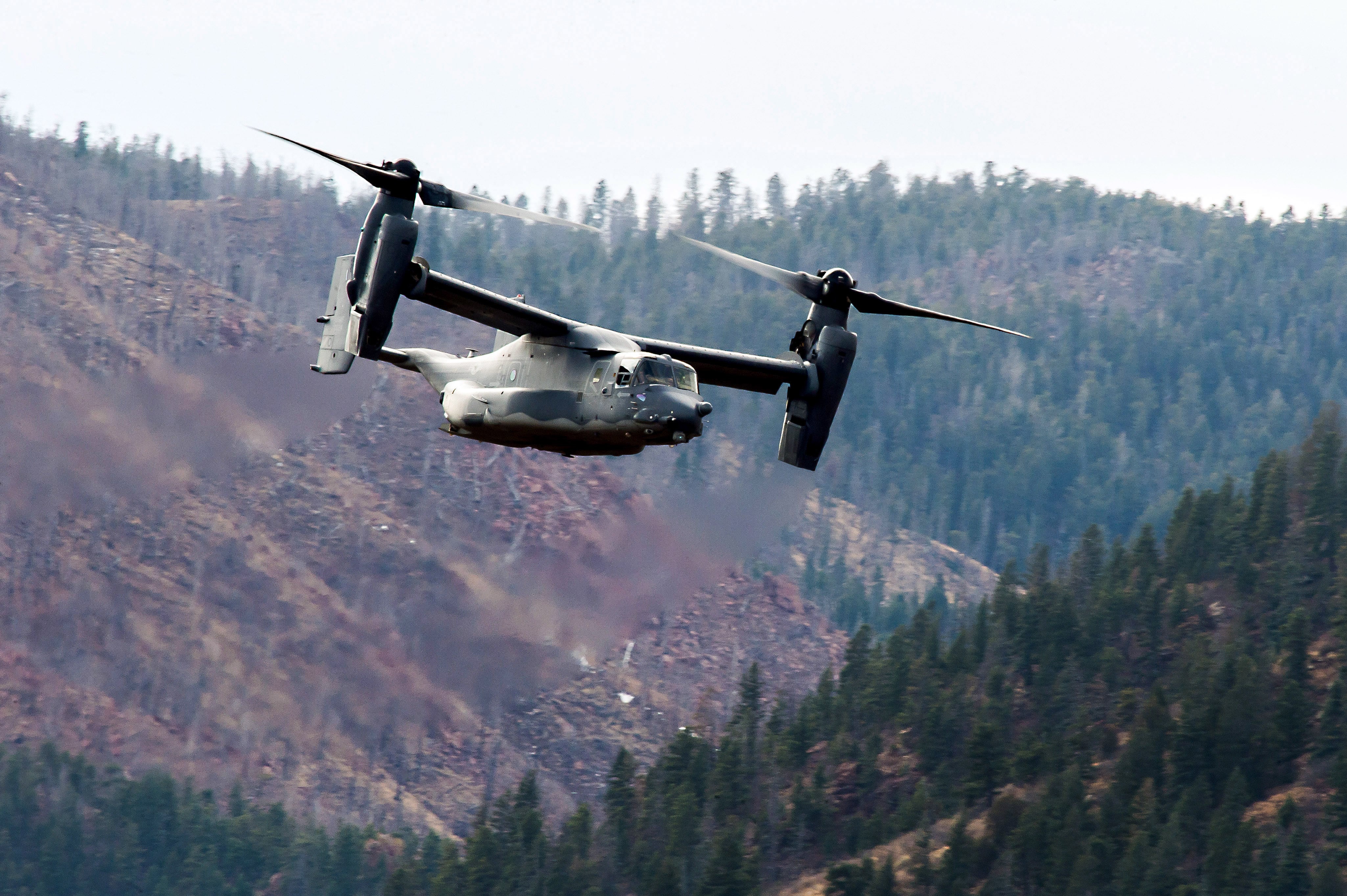Update 10:15 a.m. ET Monday: This story has been updated with additional comment from Marine spokeswoman Capt. Alyssa Myers about the 26th Marine Expeditionary Unit’s authorization to use Ospreys in emergencies.
Updated 10 a.m. ET Tuesday: This story has been updated with the corrected information that the three-star command in charge of the 26th Marine Expeditionary Unit is Naval Forces Central Command.
With all the U.S. military’s V-22 Ospreys grounded after a deadly crash in November, the Marine Corps has had to rely on other platforms to replace the go-to transport aircraft.
The V-22 Joint Program Office grounded all of the U.S. military’s Ospreys a week after a Nov. 29 crash off the coast of Japan killed eight Air Force Special Operations Command service members and renewed fears about the safety of the aircraft. The grounding has left the Marine Corps without the aircraft it usually relies on for the speedy transport of people and equipment, even as one expeditionary unit is deployed to the Middle East region amid a war between Israel and Hamas.
The 26th Marine Expeditionary Unit is, however, “authorized to conduct limited operations of the Osprey in support of emergent operational necessity with the authorization of the three-star commanding officer,” Marine spokeswoman Capt. Alyssa Myers told Marine Corps Times via email on Monday, after this story was initially published. The Navy said Tuesday that three-star command is Naval Forces Central Command.
Otherwise, the Marine Corps is complying with the order to ground Ospreys, according to Myers.
But the Marine Corps says it is making do.
“When the MV-22 is not available, the Marine Corps has multiple highly-capable aviation platforms to support Combatant Commander requirements,” Myers told Marine Corps Times on Wednesday.
The Corps is relying on the UH-1Y Venom and CH-53E Super Stallion helicopters and the transport plane KC-130J Hercules, plus aircraft from other branches, according to Myers.
What is the MV-22 Osprey?
The Osprey, which can take off vertically like a helicopter and fly horizontally like a plane, is designed to provide quick movement of troops, supplies and equipment even in tough-to-reach areas that lack a runway.
The MV-22, the Marine Corps’ Osprey variant, reached initial operational capability in June 2007 and quickly was put to use in Iraq, where one commander declared it had turned his battle space “from the size of Texas into the size of Rhode Island.”
RELATED

The Corps’ aviation modernization plan from 2022 says the Osprey will be an “integral” part of the fleet for decades to come, citing the aircraft’s “unrivaled ship-to-shore speed.”
“No peer or near-peer adversary has a similar capability,” the aviation plan states.
But the aircraft has been involved in a series of deadly crashes. In February, the V-22 Joint Program Office temporarily grounded Ospreys to replace clutch parts that the office determined had contributed to a dangerous mechanical problem known as a hard clutch engagement.
The Marine Corps on Dec. 6 attributed the recent deadly mishap in the Air Force to “a potential materiel failure” but said it didn’t yet know “the underlying cause of the failure.”
How the Marine Corps is adapting to the grounding
Myers pointed to three Marine Corps aircraft as other “highly-capable assault support platforms” the service can use for moving equipment, supplies and people from ship to shore while the Osprey is grounded.
The Marine Corps has the UH-1Y Venom, a multi-purpose helicopter that can do jobs that include close air support, search and rescue, and command and control.
It has the CH-53E Super Stallion, a helicopter that can transport troops and haul heavy equipment.
And it has the KC-130J Hercules, a medium-sized fixed-wing aircraft whose roles include transport of people and cargo, aerial refueling for other aircraft, and reconnaissance.
The Marine Corps could also rely on helicopters from other services: the Navy’s SH-60 Seahawk and the Army’s CH-47 Chinook and UH-60 Black Hawk, according to Myers.
Before the grounding, the special-operations-capable 26th Marine Expeditionary Unit was using Ospreys, according to Myers. Myers declined to specify how many of the aircraft the unit possesses.
The 26th Marine Expeditionary Unit, a II Marine Expeditionary Force unit, currently falls under Naval Forces Central Command, headed by Vice Adm. Brad Cooper, Navy spokeswoman Lt. Katherine Serrano said Tuesday.
The U.S. Naval Institute first reported that the 26th Marine Expeditionary Unit could fly Ospreys in emergencies.
It’s unclear exactly where the crisis-response unit, embarked across three Navy ships, is located.
Two of the ships, the amphibious assault ship Bataan and the dock landing ship Carter Hall, were in the Red Sea as of early November and late October, photos on the Defense Visual Information Distribution Service show. Subsequent images have been less specific but indicate the pair of ships is in the 5th Fleet’s area of operations, meaning the area encompassing the Arabian Gulf, the Red Sea, the Gulf of Oman and parts of the Indian Ocean.
In October, the two ships departed early from a scheduled training exercise with Kuwait days after the Israel-Hamas war broke out. Central Command told Marine Corps Times on Oct. 18 that the Marines were “on a higher readiness status and prepared to respond should the Department have need.”
The rest of the Marine unit is embarked aboard the amphibious transport dock Mesa Verde. That ship as of Dec. 2 was in Greece for a training exercise, in which U.S. and Greek forces practiced using Ospreys to recover aircraft and people.
The 15th Marine Expeditionary Unit and the 31st Marine Expeditionary Unit also had been using Ospreys as they trained for upcoming deployments, according to Myers.
Despite the grounding, the Corps is still performing maintenance on its Ospreys and “maintaining currency and proficiency through all means available,” Myers said.
Irene Loewenson is a staff reporter for Marine Corps Times. She joined Military Times as an editorial fellow in August 2022. She is a graduate of Williams College, where she was the editor-in-chief of the student newspaper.





